holes for airflow vent) with the air vent. It may be utilized in conjunction with the Airflow Sleeve to seal better the
airflow hot exhaust.
Figure 10. Airflow Vent Installation
Example of Airflow optimization
This is an example showing the optimizations with the Airflow Sleeve.
In a Data Center where the FEX is back of rack aligned, using standard front-to-back airflow (power supply side
intake), the temperature at the intake is at 35 degrees as shown on Figure 11. After installation of the Airflow
Sleeve, the temperature decreased by 7 degrees Celsius as shown on Figure 12. It is to note, that this is an
example of temperature reduction due to the Airflow Sleeve. The temperature delta may vary based on
environments, for example the decrease can reach higher values for warmer environments.
Figure 11. Nexus 2000 Temperature without the Airflow Sleeve (as shown on Figure 4)
Figure 12. Nexus 2000 Temperature with the Airflow Sleeve (as shown on Figure 6)

